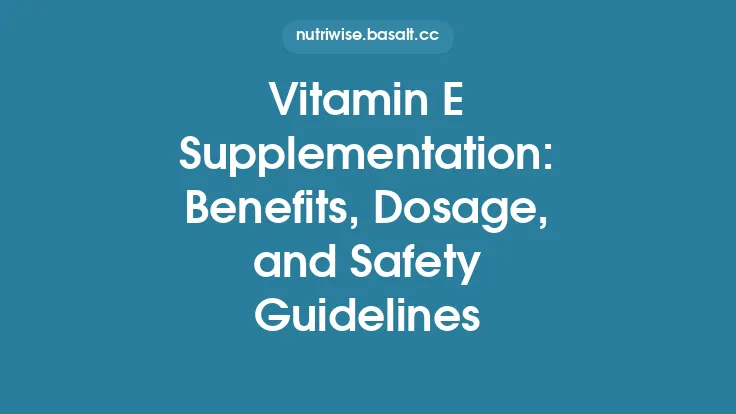Vitamin D is unique among the micronutrients because the body can synthesize it when the skin is exposed to ultraviolet B (UV‑B) radiation. This dual origin—endogenous production and dietary intake—makes vitamin D a cornerstone of human health, influencing processes that extend far beyond the classic role of supporting calcium balance. Understanding how vitamin D functions, where it can be obtained, and how to supplement it safely is essential for anyone looking to maintain optimal health throughout the lifespan.
What Is Vitamin D and How It Works in the Body
Vitamin D refers to a group of fat‑soluble secosteroids, the most biologically important of which are vitamin D₃ (cholecalciferol) and vitamin D₂ (ergocalciferol). Both forms are biologically inert until they undergo two hydroxylation steps:
- First hydroxylation in the liver – Vitamin D is converted to 25‑hydroxyvitamin D [25(OH)D], also known as calcidiol. This metabolite is the primary circulating form and the standard marker used to assess vitamin D status.
- Second hydroxylation in the kidney (and in some extra‑renal tissues) – 25(OH)D is further hydroxylated to 1,25‑dihydroxyvitamin D [1,25(OH)₂D], or calcitriol, the hormonally active form that binds to the vitamin D receptor (VDR) in target cells.
The VDR is a nuclear transcription factor present in virtually every cell type, allowing vitamin D to modulate the expression of hundreds of genes. Through this genomic pathway, vitamin D exerts pleiotropic effects on immune regulation, cell proliferation, differentiation, and metabolic processes.
Key Physiological Benefits of Adequate Vitamin D Status
While the classic function of vitamin D in facilitating intestinal calcium absorption is well known, research over the past two decades has uncovered a broader spectrum of benefits:
| System | Primary Benefit | Mechanistic Insight |
|---|---|---|
| Immune System | Enhances innate immunity (e.g., antimicrobial peptide production) and modulates adaptive responses to reduce excessive inflammation. | 1,25(OH)₂D up‑regulates cathelicidin (LL‑37) and defensins in macrophages and epithelial cells. |
| Musculoskeletal | Supports muscle strength and function, reducing fall risk in older adults. | VDR activation in muscle cells influences calcium handling and protein synthesis. |
| Cardiovascular | May improve endothelial function and lower blood pressure. | Vitamin D influences the renin‑angiotensin‑aldosterone system (RAAS) and nitric oxide production. |
| Metabolic | Contributes to insulin secretion and sensitivity. | VDR signaling in pancreatic β‑cells and adipocytes affects glucose homeostasis. |
| Cancer Prevention (observational) | Higher 25(OH)D levels are associated with reduced incidence of certain cancers (colorectal, breast, prostate). | Vitamin D can induce cell cycle arrest, promote apoptosis, and inhibit angiogenesis. |
It is important to note that while observational data are compelling, randomized controlled trials (RCTs) have produced mixed results. Nonetheless, maintaining sufficient vitamin D status remains a prudent public‑health strategy given its low risk and broad physiological relevance.
Risk Factors and Populations Prone to Deficiency
Vitamin D deficiency is defined by serum 25(OH)D concentrations below 20 ng/mL (50 nmol/L) according to most international guidelines. Several intrinsic and extrinsic factors predispose individuals to low levels:
- Limited Sun Exposure – High latitudes, winter months, indoor occupations, and extensive use of sunscreen (> SPF 30) reduce cutaneous synthesis.
- Skin Pigmentation – Melanin absorbs UV‑B photons, requiring longer exposure times for equivalent vitamin D production in darker‑skinned individuals.
- Age – Elderly skin has reduced 7‑dehydrocholesterol content, diminishing synthesis capacity.
- Obesity – Vitamin D is sequestered in adipose tissue, lowering its bioavailability in the circulation.
- Malabsorption Syndromes – Celiac disease, inflammatory bowel disease, and bariatric surgery can impair dietary absorption of fat‑soluble vitamins.
- Renal or Hepatic Impairment – Compromised hydroxylation steps limit conversion to active metabolites.
- Certain Medications – Glucocorticoids, anticonvulsants, and some antifungals accelerate vitamin D catabolism.
Identifying these risk groups enables targeted screening and early intervention.
Primary Dietary Sources and the Role of Sunlight
Because endogenous synthesis can meet most of the body’s needs under optimal conditions, dietary vitamin D is often considered a supplemental “insurance policy.” Nonetheless, several foods provide meaningful amounts:
| Food Category | Typical Vitamin D Content (IU per serving) |
|---|---|
| Fatty fish (e.g., salmon, mackerel, sardines) | 300–600 |
| Cod liver oil | 400–1,000 |
| Fortified dairy (milk, yogurt) | 100–150 |
| Fortified plant milks (soy, almond) | 80–120 |
| Fortified breakfast cereals | 40–100 |
| Egg yolk (from hens fed vitamin D‑rich feed) | 40–50 |
| Beef liver | 40 |
*IU = International Units; 1 µg = 40 IU.*
Sunlight remains the most efficient source. Roughly 5–30 minutes of midday sun exposure to uncovered arms and legs, 2–3 times per week, can generate 1,000–2,000 IU of vitamin D, depending on latitude, season, skin type, and atmospheric conditions. However, individual variability is high, and reliance on sun alone can be unreliable, especially in higher latitudes or during winter.
Bioavailability of Different Vitamin D Forms
Two primary forms are used in supplements and fortified foods:
- Vitamin D₃ (cholecalciferol) – Derived from animal sources and skin synthesis; consistently demonstrates higher potency and longer half‑life (≈ 15 days) compared to D₂.
- Vitamin D₂ (ergocalciferol) – Plant‑derived, often used in vegan formulations; exhibits a slightly lower affinity for the VDR and a shorter half‑life (≈ 10 days).
Meta‑analyses of head‑to‑head trials show that, when administered at equivalent IU doses, D₃ raises serum 25(OH)D concentrations by 1.5–2 ng/mL more than D₂ over a 12‑week period. Consequently, most clinical guidelines favor D₃ for supplementation, unless dietary restrictions dictate otherwise.
Assessing Vitamin D Status: Laboratory Tests and Interpretation
The gold standard for evaluating vitamin D status is the serum concentration of 25(OH)D, measured by:
- Immunoassays (e.g., chemiluminescent, ELISA) – Widely available, relatively inexpensive, but may suffer from cross‑reactivity with other metabolites.
- Liquid Chromatography–Tandem Mass Spectrometry (LC‑MS/MS) – Higher specificity and accuracy; considered the reference method, especially for research and complex clinical cases.
Interpretation thresholds (subject to regional guideline variations):
| Category | Serum 25(OH)D (ng/mL) | Serum 25(OH)D (nmol/L) |
|---|---|---|
| Deficient | < 20 | < 50 |
| Insufficient | 20–29 | 50–74 |
| Sufficient | 30–50 | 75–125 |
| Potentially excessive | > 50 | > 125 |
Routine testing is recommended for high‑risk groups, individuals on medications affecting vitamin D metabolism, and patients with unexplained musculoskeletal symptoms.
Evidence‑Based Supplementation Guidelines
Guidelines differ slightly among health authorities, but consensus exists on core principles:
- Baseline Assessment – Obtain a serum 25(OH)D measurement before initiating supplementation in at‑risk individuals.
- Loading (if needed) – For confirmed deficiency, a loading regimen of 50,000 IU of vitamin D₃ weekly for 6–8 weeks (or 5,000–10,000 IU daily) is commonly employed, followed by a maintenance dose.
- Maintenance Doses – General adult recommendations:
- Adults ≤ 70 years: 600–800 IU/day (15–20 µg) to maintain sufficiency.
- Adults > 70 years: 800–1,000 IU/day (20–25 µg) due to reduced skin synthesis.
- Obese individuals (BMI ≥ 30 kg/m²): Consider 1.5–2 × the standard dose, as adipose sequestration lowers circulating levels.
- Special Populations – Pregnant and lactating women often receive 600–1,000 IU/day, though some societies advocate up to 2,000 IU/day to ensure adequate maternal and infant stores.
- Monitoring – Re‑measure serum 25(OH)D 3–4 months after initiating therapy; adjust dose to achieve target concentrations (30–50 ng/mL for most adults).
These recommendations assume normal renal and hepatic function and no interfering medications.
Safety Considerations, Upper Limits, and Potential Toxicity
Vitamin D toxicity is rare and typically results from chronic intake of excessively high supplemental doses. The primary adverse effect is hypercalcemia, which can manifest as nausea, polyuria, nephrolithiasis, and, in severe cases, vascular calcification.
- Tolerable Upper Intake Level (UL) – Most agencies set the UL for adults at 4,000 IU/day (100 µg). Some research suggests that intakes up to 10,000 IU/day remain safe for short periods, but routine use above the UL is not advised without medical supervision.
- Signs of Excess – Persistent serum 25(OH)D > 150 ng/mL (375 nmol/L) warrants evaluation for toxicity, especially if accompanied by elevated calcium or renal dysfunction.
- Contraindications – Patients with sarcoidosis, tuberculosis, or other granulomatous diseases may develop hypercalcemia at lower vitamin D doses due to extrarenal conversion of 25(OH)D to 1,25(OH)₂D.
Interactions with Medications and Other Nutrients
Vitamin D metabolism can be altered by several pharmacologic agents:
| Medication | Effect on Vitamin D | Clinical Implication |
|---|---|---|
| Anticonvulsants (phenytoin, phenobarbital) | Induce hepatic CYP enzymes → increased catabolism | May require higher supplementation |
| Glucocorticoids | Reduce intestinal calcium absorption and impair VDR expression | Monitor 25(OH)D and consider higher doses |
| Rifampin | Accelerates vitamin D degradation | Adjust supplementation accordingly |
| Cholestyramine | Binds fat‑soluble vitamins → decreased absorption | Separate dosing times (≥ 4 h apart) |
Nutrient interactions:
- Magnesium – A cofactor for the enzymes that hydroxylate vitamin D; deficiency can blunt the response to supplementation.
- Vitamin K₂ – Works synergistically with vitamin D in calcium metabolism; while not a direct interaction, balanced intake may support optimal skeletal health.
Practical Tips for Optimizing Vitamin D Levels Year‑Round
- Sun Smart – Aim for short, regular midday exposures (5–15 minutes) on uncovered skin when UV‑B is adequate; avoid sunburn.
- Seasonal Adjustments – Increase dietary intake or supplement during fall/winter when UV‑B intensity drops below 10 % of its peak.
- Choose D₃ Formulations – Unless vegan, opt for cholecalciferol for better efficacy.
- Take with Fat – Vitamin D is fat‑soluble; ingest with a meal containing 5–10 g of dietary fat to enhance absorption.
- Mind the Timing – Consistency matters more than timing; a daily dose is easier to maintain than intermittent high‑dose regimens for most people.
- Track Your Status – Keep a record of serum 25(OH)D results and supplement doses; adjust based on trends rather than isolated values.
- Consider Combined Products – Some fortified foods (e.g., dairy, plant milks) provide modest vitamin D alongside calcium or vitamin K₂, offering a balanced approach.
Frequently Asked Questions
Q: Can I rely solely on sunlight for my vitamin D needs?
A: In theory, adequate sun exposure can meet requirements, but factors such as latitude, season, skin pigmentation, age, and lifestyle often limit synthesis. A modest dietary or supplemental source provides a safety net.
Q: Is vitamin D supplementation necessary for people who exercise regularly?
A: Physical activity does not replace vitamin D. In fact, athletes, especially those training indoors, may have higher requirements to support muscle recovery and immune resilience.
Q: How quickly does supplementation raise serum 25(OH)D?
A: On average, a daily intake of 1,000 IU raises serum 25(OH)D by ~10 ng/mL (25 nmol/L) over 8–12 weeks, though individual response varies.
Q: Are there any natural food sources that provide enough vitamin D without fortification?
A: Fatty fish and cod liver oil are the richest natural sources, but typical serving sizes often fall short of daily needs, making fortified foods or supplements valuable.
Q: Should I take vitamin D with calcium supplements?
A: Calcium and vitamin D work synergistically, but they can be taken separately. If you have adequate dietary calcium, vitamin D alone may suffice; otherwise, a combined supplement can simplify dosing.
Q: What is the best time of day to take vitamin D?
A: There is no definitive evidence that timing (morning vs. evening) affects absorption. Choose a time that fits your routine and ensures consistent daily intake.
Maintaining optimal vitamin D status is a dynamic process that balances sun exposure, diet, individual risk factors, and, when needed, thoughtful supplementation. By understanding the underlying physiology, recognizing who is most vulnerable to deficiency, and applying evidence‑based dosing strategies, individuals can harness the full spectrum of vitamin D’s health‑promoting potential while minimizing risks. This approach aligns with the broader goal of informed, proactive micronutrient management within the realm of supplement fundamentals.





